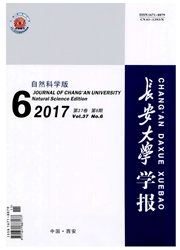

 中文摘要:
中文摘要:
为了研究出行者路径选择行为与信息发布的方式和出行者心理特性的关系,采用计算机仿真的方法,研究了突发事件下完全理性出行者和有限理性出行者的路径选择行为。首先提出了事故消散时间模型,对事故消散的流程进行了分析,建立了事故消散时间与进入路段的驾驶人流量之间的关系模型;然后对机动车出行者进行分类,将出行者分为完全理性出行者和有限理性出行者,提出了不同类型驾驶人路径选择的方法;进一步针对不同类型驾驶人,分析了出行者路径选择结果与进入路段的流量、出行者理性程度、非理性出行者的比例之间的关系。通过不断为出行者提供事故消散时间信息,研究不同时刻进入系统的驾驶人路径选择规律,直到事故消散。研究结果表明:信息发布更新越快,完全理性出行者所占比例越小,则事故消散时间也越短;事故消散时间与出行者对预测信息的依赖程度无关;理性出行者所占比例越大,事故道路上出现有限理性出行者所需的时间越长,道路上交通流变化幅度越小;道路恢复正常前,各路段的流量均经过较大幅度的变化。
 英文摘要:
英文摘要:
In order to analyze the relationship between drivers' route-choice behavior and information providing approach and psychological characteristics of drivers, simulation method was adopted to study the route-choice behavior of completed rational drivers and boundedly rational drivers under emergency. First, model of accident dissipation time was proposed, the progress of accident dissipation was analyzed, and the relationship model of accident dissipation time and drivers number flowing into the road was established. Then, drivers were classified into completely rational drivers and boundedly rational drivers, and route-choice methods for different drivers were proposed. Aimed at different types of drivers, the relationship between drivers' route-choice and traffic volume, rational degree, proportion of boundedly rational drivers were analyzed. Through providing accident dissipation time information, principle of drivers' route- choice in different time was studied until the influence of accident was completely cleared. Theresults show that accident dissipation time is shorter when information announcing speed is faster and proportion of completed rational drivers is smaller. Accident dissipation time has no relationship with the dependence of drivers on the forecast information. The greater proportion of rational drivers, the longer the time that boundedly rational drivers emerge on the road, and the smaller the change degree of traffic flow. Before the road returns to normal state, traffic volume of each road has been greatly changed.
 同期刊论文项目
同期刊论文项目
 同项目期刊论文
同项目期刊论文
 期刊信息
期刊信息
